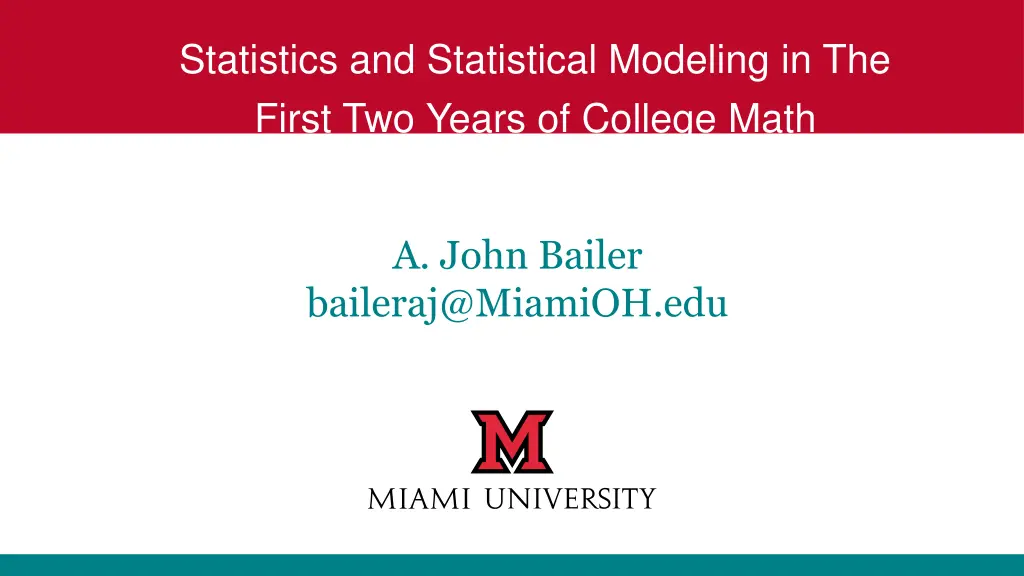
Importance of Statistics and Statistical Modeling in Education and Professional Fields
Explore the significance of statistics and statistical modeling in various educational disciplines and professional sectors. Discover the crucial role of quantitative literacy, engineering applications, and data-driven decision-making in a data-rich world. Uncover the growing demand for professionals with analytical skills in data-related job positions.
Download Presentation

Please find below an Image/Link to download the presentation.
The content on the website is provided AS IS for your information and personal use only. It may not be sold, licensed, or shared on other websites without obtaining consent from the author. If you encounter any issues during the download, it is possible that the publisher has removed the file from their server.
You are allowed to download the files provided on this website for personal or commercial use, subject to the condition that they are used lawfully. All files are the property of their respective owners.
The content on the website is provided AS IS for your information and personal use only. It may not be sold, licensed, or shared on other websites without obtaining consent from the author.
E N D
Presentation Transcript
Statistics and Statistical Modeling in The First Two Years of College Math A. John Bailer baileraj@MiamiOH.edu
Outline In my remarks, I will consider the general question of when statistics and statistical modeling encountered in the curriculum Why is this important? Past patterns Present (& evolving) practice Future opportunities
Context of remarks My remarks apply to the statistics and statistical modeling background of needed by both STEM majors and to non-STEM majors. My remarks extend beyond the uses of math in physical sciences category of this panel
Importance of statistics and stat modeling? [Gen. Ed.] Quantitative Literacy / Data analytic skills are a critical component of a general education (AAC&U LEAP core competency https://www.aacu.org/leap) competency and comfort working with numerical data ability to reason and solve quantitative problems from a wide array of authentic contexts and everyday life situations understand and can create sophisticated arguments supported by quantitative evidence clearly communicate those arguments
Importance of statistics and stat modeling? [Engineering] ABET criteria for bioengineering (and others) curriculum: an understanding of biology and physiology capability to apply advanced mathematics (including differential equations and statistics) For manufacturing engineering: (d) manufacturing systems design: ability to analyze, synthesize, and control manufacturing operations using statistical methods
Why is this important? [data rich world] Data collected on all phases of life and decisions based on models derived from these data (e.g., health decisions from risk models, recommender systems). Data in context matters (who was studied? Is this relevant for me?) Skepticism of what is reported is healthy (was a predictive model validated?)
Why is this important? Skills for extracting information and insight from data are in demand indeed.com search (02oct14) statistician 1632 jobs statistical analyst 13647 jobs statistical programmer 2402 jobs data scientist 11791 jobs marketing research analyst 6700 many positions require proven data gathering and analytical skills
Past Patterns Early 80 s Statistics intro course began to change less procedural and more conceptual Intro. to Practice of Statistics (Moore & McCabe) included sections that addressed: describing data collecting data drawing conclusions from data Regression for describing relationship between 2 vars (not much in ways of explicit modeling)
Past Patterns Early 80 s Statistics and Mathematics majors positioned to not encounter any data analysis until their 3rd year of study. First, Calc I, Calc II, Calc III, Linear Algebra, Probability Then, Math Stat (estimation, testing, etc.) Finally, Regression [first time power of data analysis modeling realized]
Present (& evolving) practice Modify curriculum so that stat and math majors (already true for STEM majors) see data analysis concepts early (only one calc prereq; see before probability) Modify curriculum so that stat and math majors can take an early intro to modeling (only one STA prereq vs. the previous courses with 3 calc + linear algebra + probability + intro stat prereqs).
Present (& evolving) practice Expansion of stat ed efforts Journal of Stat Ed First volume 1993 - http://www.amstat.org/publications/jse/ ICOTS 1982 (every 4 years) USCOTS 2005 (every 2 years) + eCOTS GAISE 2005 (college version) - http://www.amstat.org/education/gaise/GaiseCollege_Full.pdf ASA guidelines for undergraduate stat curriculum (2000 and 2014 revision in progress)
Present (& evolving) practice New introductory curriculum reflecting key GAISE ideas (e.g. emphasize stat literacy, use real data, stress concepts rather than procedures, active learning, use tech, assess) Introductory statistics using randomization and bootstrapping principles Statistics: Unlocking the Power of Data (www.lock5stat.com) Workshop Statistics(http://www.rossmanchance.com/ws/) Introduction to Statistical Investigations (http://www.math.hope.edu/isi/)
Present (& evolving) practice New accessible modeling books Stat2 http://www.amazon.com/STAT2-Book-Companion-Premium-Access/dp/1464148260 designed to help students build on their statistical knowledge in order to analyze rich datasets using statistical models. The book develops a systematic approach to using different models and includes exercises to allow students to practice working with real data alongside output from statistical software.
Future opportunities Greater number of students with AP statistics credit entering college (169K in 2013, 98K scored 3+; 185K in 2014) College board lists AP stat exam as can lead to a future in 106 Career Areas and 32 College Majors Common Core statistics and probability includes interpret linear models (http://www.corestandards.org/Math/Content/HSS/introduction/) MS and HS students will be doing simulations in classes
Future opportunities How will we change the statistics curriculum in response to more students entering college with AP Stat credit and with years of exposure to statistics and probability concepts in the common core? One possible answer: the current stat 2 class (intro to stat models) will become the future stat 1 class.






















